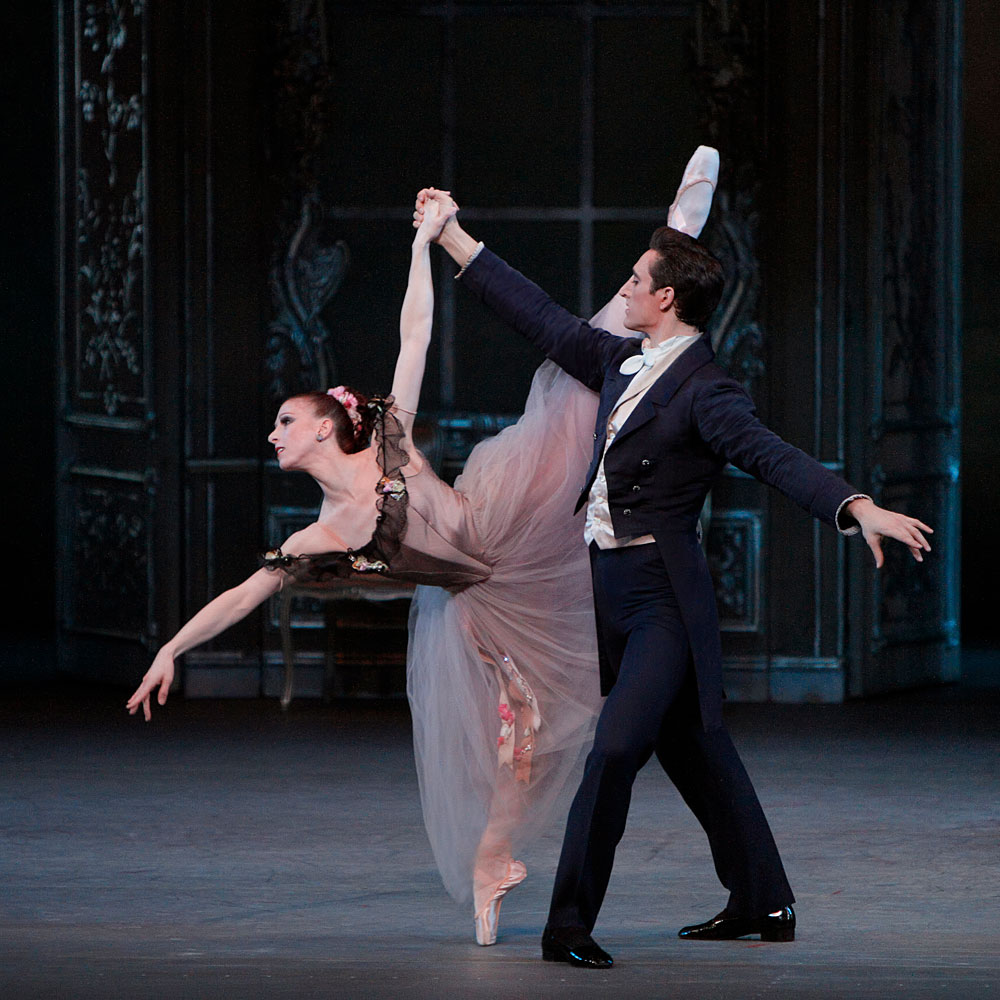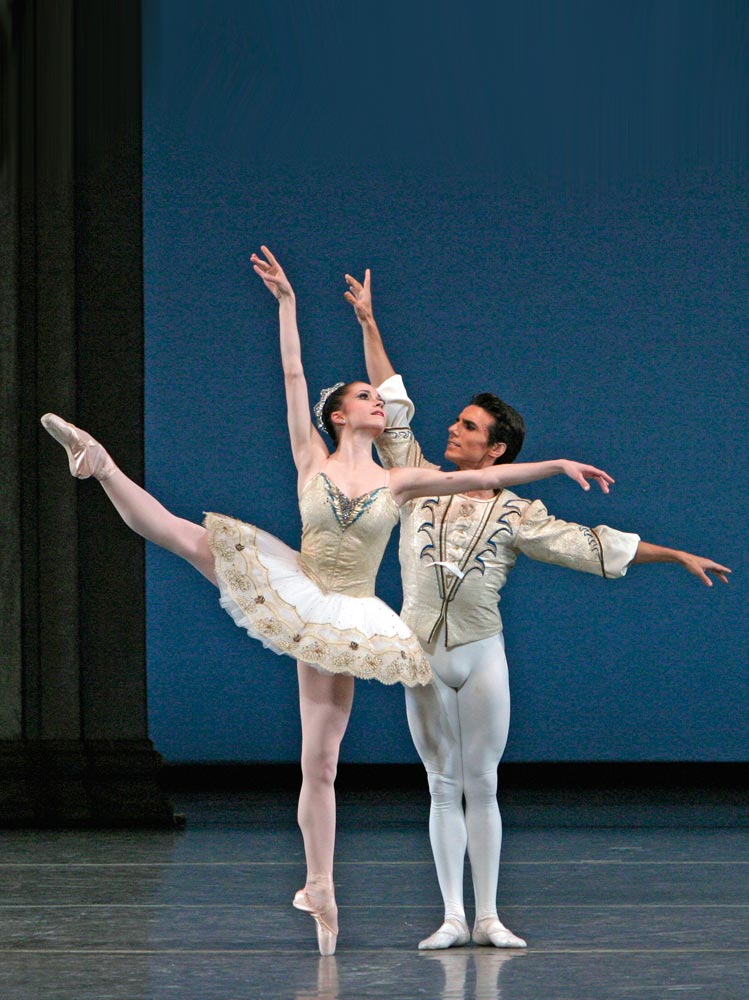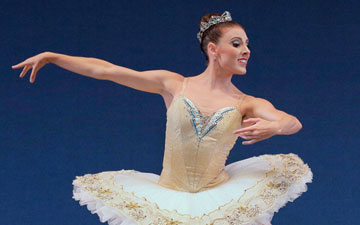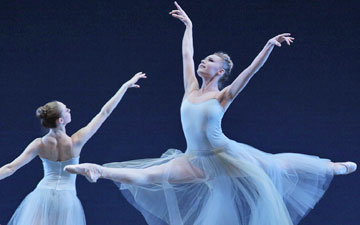
© Paul Kolnik. (Click image for larger version)
New York City Ballet
Liebeslieder Walzer, Tchaikovsky Suite No. 3
New York, David H. Koch Theater
3 October 2015
www.nycballet.com
Love Songs
George Balanchine’s ballets are often romantic, but seldom in a detailed, homey sort of way. In his hands emotion is distilled into pure essence, mysterious and ineffable. But there are exceptions; the1960 ballet Liebeslieder Walzer is one of them. (Davidsbündlertänze, from 1980, is another). In Liebeslieder, which returned to the repertoire this week after three years out of rotation, four couples gather in a Belle Époque parlor to dance and listen to music. We see them in a domestic setting; their dancing, which is accompanied by two Brahms song-cycles performed onstage by four singers and two pianists, is filled with moments of staggering intimacy. This is particularly true of the first half, which is danced in floor-length gowns and heeled shoes. In the second, the dancers revert to pointe shoes and romantic tulle skirts. It is more impersonal, more about dancing. The first is about being.
The curtain rises to reveal a freeze-frame of a scene that has already begun. Four couples dance a fast waltz. It is implied that these people know each other well, are connected by friendship and shared experience. At one point the men form a small circle, their arms around each other’s shoulders; the women join them, and they turn, tightly interconnected, for a few bars.

© Paul Kolnik. (Click image for larger version)
Very soon, Balanchine begins to reveal private details about each rapport. A man whispers into a woman’s ear, and she raises her hand and falters slightly, almost blushing. Another couple struggles to find equilibrium as the woman pulls away again and again; later, her partner hides his face from her with one gloved hand. Yet another man gently pushes his partner forward by the shoulders, an act of support and encouragement, or perhaps of something less tender. Intimacy, hesitation, fear, dependence, all have their moment. A flirtatious trio leads to a more raucous one in which the men cut each other off, almost discourteously, as if emboldened by too much champagne.
The second section, performed after a short break, is less intimate, the dancing more generically balletic. The set’s French doors are now open, revealing a dark sky. The couples enter one at a time. What was a gathering has become a suite of dances. But again, the tone shifts with the final pas de deux, which contains one of the most heart-catching phrases of movement in all of ballet. The woman falls back against her partner and he lifts her slightly, then places his arms around her hips and lowers her toward the floor; with exquisite slowness she unfolds one leg and traces an arc, then pulls herself up. Together, they become a single being, advancing slowly through space, like a ship through a dark ocean. And there it is, the mystery of life. The moment passes and the couples return, taking their places among the gilded armchairs. An evening, a cycle, has come to an end.

© Paul Kolnik. (Click image for larger version)
It’s a complex ballet, and one that needs dancers with powerful imaginations, a sense of time and place, and an ability to project experience. Older casts tend to dance it better. (This was one of Jenifer Ringer’s best roles.) The current cast – Sterling Hyltin, Ashley Laracey, Sara Mearns, Jennie Somogyi, Jared Angle, Tyler Angle, Justin Peck, and Ask la Cour – contains a mix of old and new. Among the women, Somogyi, who has danced it many times and will perform it at her farewell on October 11, is the most at home in its semi-narrative world. She adds notes of surprise, of drama and vulnerability to her interpretation. She also gives in to the lilt and bend of the waltz, using her hips, her shoulders. The off-the shoulder dress sets off her beautiful neck. Jared Angle, too, adds touches of impetuousness and ardor to his character. It is Angle who dances the final, ocean-liner-on-the-high-seas pas de deux, with Sterling Hyltin.
Ashley Laracey, new to the ballet, has a lovely vulnerability and lyricism and a beautiful line in arabesque; her partner, Justin Peck, is attentive and musical, but shows little emotion in his face. With time, they’ll grow into their roles. Sara Mearns, more used to ballets that require greater projection, hasn’t quite found her footing here. Tyler Angle and Ask la Cour are suitably elegant but don’t register much. A great Liebeslieder is like a short story, a complete world in fifty minutes of dancing; this Liebeslieder is still a work in progress.

© Paul Kolnik. (Click image for larger version)
The evening closed with a performance of Tchaikovsky Suite No. 3, Balanchine’s elaboration on his 1947 ballet, Theme and Variations. In 1970 he added three sections, all of them sweepingly romantic, filled with women in long, gauzy dresses, dancing with their hair loose. Once again, Teresa Reichlen was ravishing as the uncontainable nymph of the opening Élegie, which is performed barefoot; her lithe frame sweeping through the air like a wisp of smoke. Even so, it’s a lot to get through in order to reach the final payoff: Theme and Variations. Nor was tonight’s Theme a banner performance. Megan Fairchild, so scintillating in light, allegro roles, is miscast here; Joaquin de Luz performed crisply – and it’s a killer role – but without a hint of profundity. The ballet’s majesty, its contrasts of joy and reverence, got lost along the way.

















You must be logged in to post a comment.